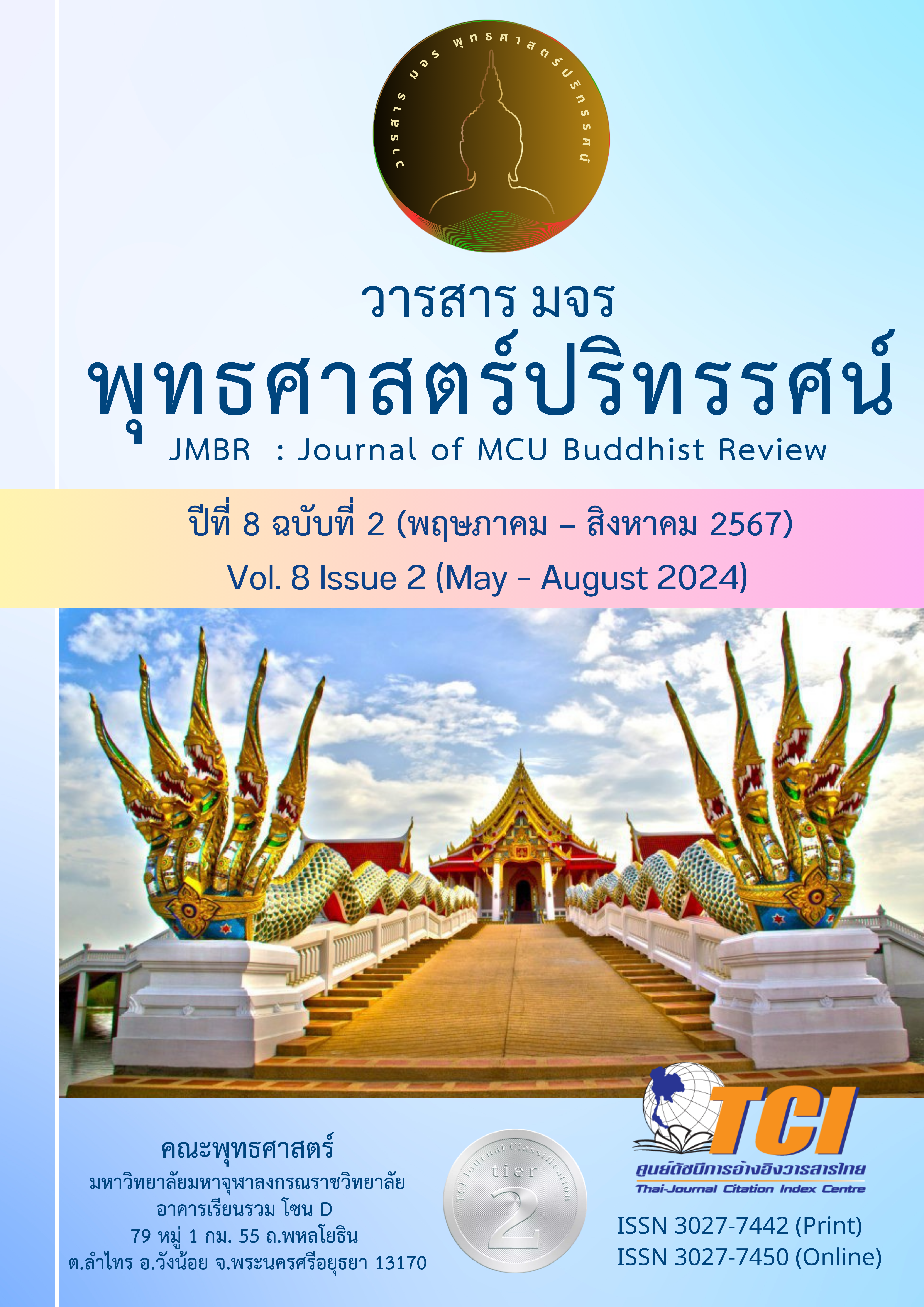ศึกษาวิเคราะห์เพศทางเลือกกับการบรรลุธรรมในพระไตรปิฎก
Main Article Content
บทคัดย่อ
บทความวิจัยนี้มีวัตถุประสงค์ 1) เพื่อศึกษาแนวคิดเรื่องเพศทางเลือกในวิทยาการสมัยใหม่และพระไตรปิฎก 2) เพื่อศึกษาการบรรลุธรรมในพระไตรปิฎก 3) เพื่อวิเคราะห์เพศทางเลือกกับการบรรลุธรรมในพระไตรปิฎก งานวิจัยนี้เป็นการวิจัยเชิงคุณภาพ ด้วยการศึกษาข้อมูลจากคัมภีร์พระไตรปิฎก และเอกสารที่เกี่ยวข้อง วิเคราะห์ข้อมูลด้วยการพรรณนาวิเคราะห์
ผลการวิจัยพบว่า 1) ในวิทยาการสมัยใหม่ เพศทางเลือกคือกลุ่มบุคคลที่มีความหลากหลายในพฤติกรรมทางเพศและเพศสรีระ ในโลกยุคปัจจุบันนี้มีมากถึง 20 เพศ มีหญิงรักหญิง ชายรักชาย เป็นต้น ส่วนเพศทางเลือกในพระไตรปิฎก หมายถึง“บัณเฑาะก์” แบ่งได้ 5 ประเภท คือ 1) อาสิตตบัณเฑาะก์ หมายถึง ชายที่เอาปากคาบอวัยเพศชายอื่นเมื่อถูกน้ำอสุจิรดเอาแล้วความเร่าร้อนจึงสงบไป 2) อุสูยบัณเฑาะก์ หมายถึง คนที่มีความรู้สึกพอใจมีความสุขเมื่อได้เห็นอัชฌาจารของผู้อื่นหรือการได้แอบดูคนอื่นสมสู่กัน 3) โอปักกมิกบัณเฑาะก์ หมายถึง ชายที่ถูกตัดอวัยวะเพศหรือถูกตอนด้วยความพยายามเรียกว่าขันที 4) ปักขบัณเฑาะก์ หมายถึง คนที่ข้างแรมเป็นบัณเฑาะก์ด้วยอานุภาพแห่งอกุศลกรรมวิบาก แต่ข้างขึ้นความเร่าร้อนของเขาก็สงบไป 5) นปุงสกบัณเฑาะก์ หมายถึง คนที่เกิดมาไม่มีเพศ ไม่มีภาวะรูปใดๆ คือไม่ปรากฏว่าเป็นชายหรือหญิงมาแต่กำเนิด 2) การบรรลุธรรมในพระไตรปิฎก พบว่า การบรรลุธรรม หมายถึง การเข้าถึงมรรคผลนิพพาน การเข้าใจธรรมในระดับต้น ๆ คือ ระดับโลกียะ จนถึงเข้าใจเข้าถึงธรรมในระดับมรรคผล คือระดับโลกุตระ 3) เพศทางเลือกหมายถึงบัณเฑาะก์เรียกว่าอภัพบุคคล แม้ว่าจะพยายามฝึกพัฒนาตนเองตามหลักไตรสิกขา ที่สุดแล้วก็ไม่สามารถที่จะบรรลุธรรมได้ในทันที เพราะว่าเป็นผู้ถือกำเนิดมาเป็นมนุษย์เพราะผลแห่งอกุศลกรรมปฏิสนธิที่ปราศจากอโมหะเหตุ คือผู้มีวิบากเป็นเครื่องกั้น แต่อย่างไรก็ตามก็ยังสามารถสั่งสมบุญเพื่อบรรลุธรรมในชาติภพต่อไป ในพระพุทธศาสนาเรียกผู้บรรลุธรรมว่าอริยบุคคล ส่วนของเพศทางเลือกแม้จะบรรลุธรรมในชาตินี้ยังไม่ได้ ก็สามารถฝึกพัฒนาและมีแนวทางการดำเนินชีวิตที่ยกระดับขึ้นมาได้ เพราะการฝึกปฏิบัติตนตามหลักไตรสิกขาเพื่อการบรรลุธรรมได้นั้นต้องมีความมั่นคงในพระรัตนตรัย ในศีล สมาธิและปัญญา
Article Details

อนุญาตภายใต้เงื่อนไข Creative Commons Attribution-NonCommercial-NoDerivatives 4.0 International License.
- บทความที่ได้รับการตีพิมพ์เป็นลิขสิทธิ์ของวารสาร มจร พุทธศาสตร์ปริทรรศน์
- ข้อความใดๆ ที่ปรากฎในบทความที่ได้รับการตีพิมพ์ในวารสาร ถือเป็นความรับผิดชอบของผู้เขียนบทความ และข้อคิดเห็นนั้นไม่ถือว่าเป็นทัศนะและความรับผิดชอบของกองบรรณาธิการวารสาร มจร พุทธศาสตร์ปริทรรศน์
เอกสารอ้างอิง
กองบรรณาธิการวอยซ์ออนไลน์. Who ประกาศ คนข้ามเพศไม่ได้ป่วยทางจิต. สืบค้น 18 มีนาคม 2567 จาก https://voicetv.co.th/read/HJVbWd8ZX#google_vignette.
กุลธิดา ติระพันธ์อำไพ. กรอบเพศแบบสองขั้ว (Gender binary): วิทยาศาสตร์ชายเป็นใหญ่ที่กดทับเด็กในระบบการศึกษา. สืบค้น 16 กันยายน 2566 จาก https://thepotential.org/knowledge/ patriarchy-in-education-system/.
คณะนิติศาสตร์ มหาวิทยาลัยธรรมศาสตร์. สร้างความเข้าใจเกี่ยวกับความหลากหลายทางเพศ & แนวทางการอยู่ร่วมกันอย่างให้เกียรติ. แปลจาก Charles Sturt University. สืบค้น 15 มิถุนายน 2566 จาก https://www.law.tu.ac.th/how-to-respect-lgbtq/
คณะนิติศาสตร์ มหาวิทยาลัยธรรมศาสตร์. LGBT+ให้เกียรติกันและกันโดยสร้างความเข้าใจเกี่ยวกับ ความหลากหลายทางเพศ. สืบค้น 19 มีนาคม 2567 จาก https://www.law.tu.ac.th/how-to-respect-lgbtq/.
ดนัย อังควัฒนวิทย์. ความหลากหลายทางเพศ. นิตยสารอิเลกทรอนิกส์ คณะแพทย์ศาสตร์โรงพยาบาลรามาธิบดี มหาวิทยาลัยมหิดล. สืบค้น 16 มีนาคม 2567 จาก https://www.rama.mahidol.ac. th/atrama/issue016
เตชิน อิสระภาณุวงค์. (2561). ศึกษาการบรรลุธรรมของฆราวาสที่ปรากฏในคัมภีร์พระพุทธศาสนา. วิทยานิพนธ์พุทธศาสตร์มหาบัณฑิต บัณฑิตวิทยาลัย: มหาวิทยาลัยมหาจุฬาลงกรณราชวิทยาลัย.
นฤพนธ์ ด้วงวิเศษ. ความหลากหลายทางเพศในกระบวนทัศน์วิทยาศาสตร์และสังคมศาสตร์. สืบค้น 16 มีนาคม 2567 จาก https://ojs.lib.buu.ac.th/index.php/huso2 /article/view/7587.
มนูญ วงษ์มะเซาะห์. ทำความรู้จักกับ LGBTQI ตัวย่อที่มีความหมายและประเด็นที่น่าสนใจในความก้าวหน้าของกลุ่ม LGBTQI ในปี 2020. สืบค้น 16 มีนาคม 2567 จาก https://www.amnesty.or.th /latest/blog/860/:
มหาจุฬาลงกรณราชวิทยาลัย. (2539). พระไตรปิฎกภาษาไทย ฉบับมหาจุฬาลงกรณราชวิทยาลัย. กรุงเทพฯ: มหาจุฬาลงกรณราชวิทยาลัย.
มหามกุฏราชวิทยาลัย. (2534). พระไตรปิฎกและอรรถกถาแปล ฉบับมหามกุฏราชวิทยาลัย. กรุงเทพฯ: มหา มกุฏราชวิทยาลัย.
มูลนิธิเด็กโสสะแห่งประเทศไทยในพระบรมราชินูปถัมภ์. Pride Month: สิทธิ์ทางเพศที่ครอบครัวควรทำความเข้าใจ. สืบค้น 16 มีนาคม 2567 จาก https://www.sosthailand.org/blog/pride-month-sexual.
บุษกร สุริยสาร. (2557). อัตลักษณ์และวิถีทางเพศในประเทศไทย. กรุงเทพฯ: องค์การแรงงานระหว่างประเทศ.
พระเจ้าบรมวงศ์เธอ กรมพระจันทบุรีนฤนาถ. (2537). ปทานุกรม บาลี ไทย อังกฤษ สันสกฤต. พิมพ์ครั้งที่ 4. กรุงเทพฯ: มหามกุฎราชวิทยาลัย.
พระเทพสิทธิมุนี (โชดก ญาณสิทธิ). (2548). คำบรรยายเรื่อง วิปัสสนากรรมฐาน (มหาสติปัฏฐาน). กรุงเทพฯ: บริษัทสหธรรมิก จำกัด.
พระธรรมปิฏก (ป.อ.ปยุตฺโต). (2541). ปฏิบัติธรรมให้ถูกทาง. พิมพ์ครั้งที่ 46. กรุงเทพฯ: บริษัท สหธรรมิก จำกัด.
พระธรรมปิฏก (ป.อ.ปยุตฺโต). (2547). ตื่นกันเสียที จากความเท็จของหนังสือ เหตุเกิด พ.ศ. 1. พิมพ์ครั้งที่ 3. กรุงเทพฯ: มูลนิธิพุทธธรรม.
พระมหาสมเจต สมจารี. (2559). ศึกษาบัณเฑาะก์กับการบรรลุธรรมขั้นสูงในพุทธศาสนาเถรวาท. วารสารศึกษาศาสตร์ มมร. 4(2), 151-165.
พระระพิน พุทธิสาโร. (2561). เฟชบุ๊กพื้นที่ทางความเชื่อและเพศ: การแสดงอัตลักษณ์ทางเพศของภิกษุ สามเณรไทย. การประชุมวิชาการระดับชาติ ครั้งที่ 5 ระดับนานาชาติ ครั้งที่ 3. มหาวิทยาลัยมหาจุฬาลงกรณราชวิทยาลัย วิทยาเขตขอนแก่น. 1-15.
พระเกรียงศักกดิ์ สิริสกฺโก (ศรีโชติ). (2565). จริยศาสตร์เพศในทรรศนะของพุทธปรัชญา. วิทยานิพนธ์หลักสูตรพุทธศาสตร์ดุษฎีบัณฑิต บัณฑิตวิทยาลัย: มหาวิทยาลัยมหาจุฬาลงกรณราชวิทยาลัย
พระมหา อุทัย ภูริเมธี (ขะกิจ). (2552). ศึกษาคุณค่าของการเกิดเป็นมนุษย์ในพระพุทธศาสนา.
วิทยานิพนธ์หลักสูตรพุทธศาสตรมหาบัณฑิต บัณฑิตวิทยาลัย: มหาวิทยาลัยมหาจุฬาลงกรณราชวิทยาลัย.
พระมหาอดิเดช สติวโร (สุขวัฒนวดี). 2555. การศึกษาวิเคราะห์กายวิภาคศาสตร์ที่เกื้อหนุนต่อการปฏิบัติกรรมฐาน. วิทยานิพนธ์หลักสูตรพุทธศาสตร์มหาบัณฑิต บัณฑิตวิทยาลัย: มหาวิทยาลัยมหาจุฬาลงกรณราชวิทยาลัย.
พระมหาอดุลย์ ยโสธโร. (2549). การศึกษาเชิงวิเคราะห์เรื่องบัณเฑาะก์กับการบรรลุธรรม. วิทยานิพนธ์หลักสูตรพุทธศาสตรมหาบัณฑิต บัณฑิตวิทยาลัย: มหาวิทยาลัยมหาจุฬาลงกรณราชวิทยาลัย.
วิศิษฐ์ ชัยสุวรรณ. (2563). พระอภิธรรม ใครว่ายาก. กรุงเทพฯ: บริษัทอัมรินทร์พริ้นติ้งแอนด์พับลิชชิ่ง จำกัด.


